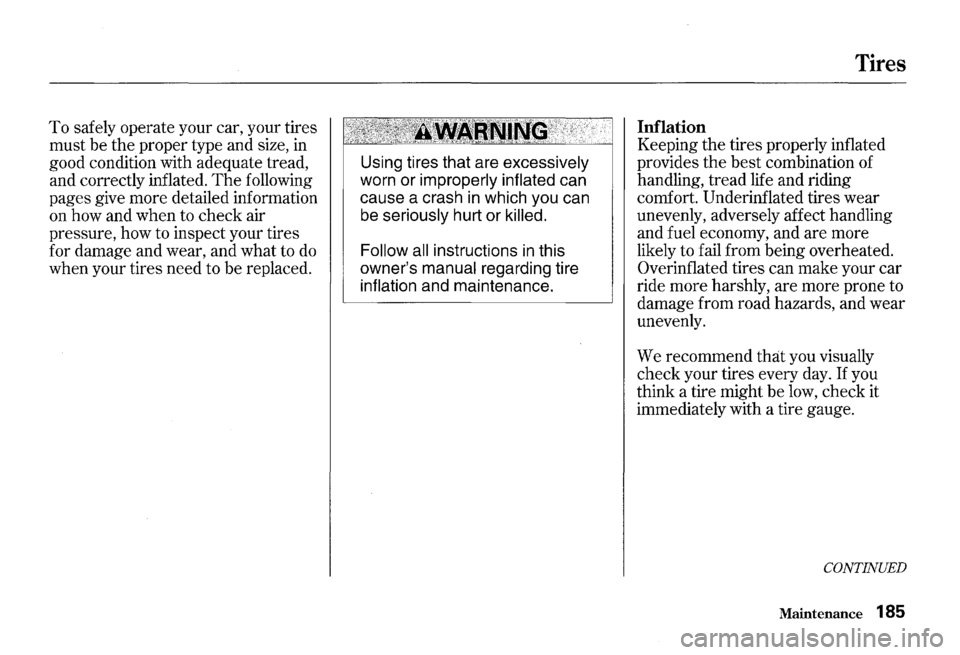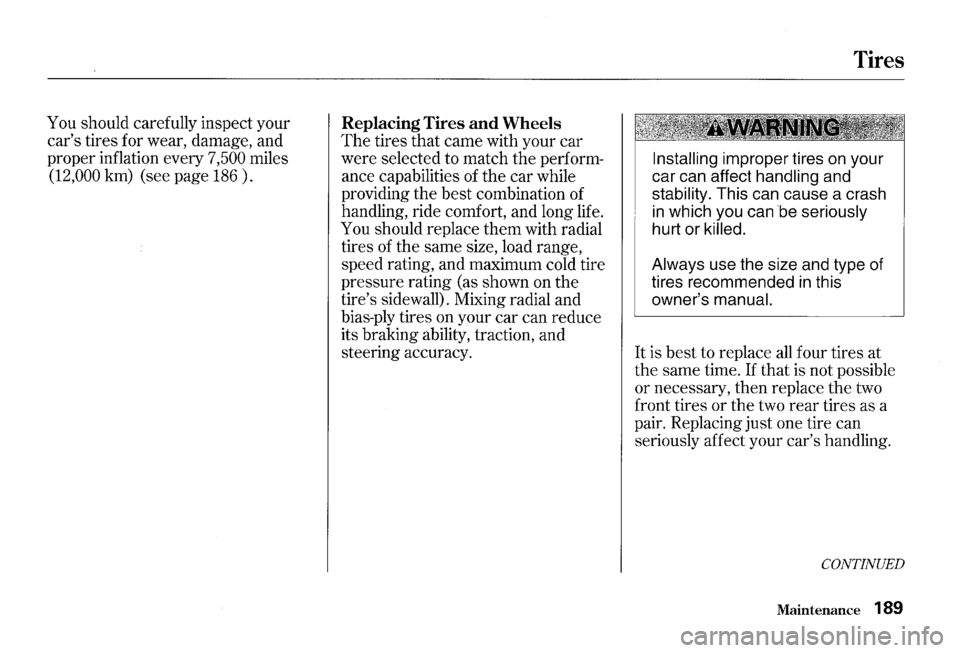2000 HONDA S2000 inflation pressure
[x] Cancel search: inflation pressurePage 188 of 273

To safely operate your car, your tires
must be
the proper type and size, in
good condition with adequate tread,
and correctly inflated.
The following
pages give more detailed information
on how and when to check air
pressure, how to inspect your tires
for damage and wear, and what to
do
when your tires need to be replaced.
Using tires that are excessively
worn or improperly inflated can
cause a crash
in which you can
be
seriously hurt or killed.
Follow all
instructions in this
owner's
manual regarding tire
inflation and maintenance.
Tires
Inflation
Keeping the tires properly inflated
provides the
best combination of
handling, tread life and riding
comfort. Underinflated tires wear
unevenly, adversely affect handling
and fuel economy, and are more
likely to fail from being overheated.
Overinflated tires can make your car
ride more harshly, are more prone to
damage from road hazards, and wear
unevenly.
We recommend that you visually
check your tires every day.
If you
think a tire might be
low, check it
immediately with a tire gauge.
CONTINUED
Maintenance 185
Page 190 of 273

Tubeless tires have some ability to
self-seal
if they are punctured.
However, because leakage is often
very slow, you should look closely
for punctures if a tire starts losing
pressure.
Inspection
Every time you check inflation, you
should also examine the tires for
damage, foreign objects, and wear.
You should look for:
• Bumps or bulges in the tread or
side of the tire. Replace the tire
if
you find either of these conditions.
• Cuts, splits, or cracks in the side
of the tire. Replace the tire
if you
can see fabric or cord.
• Excessive tread wear.
Tires
Your car's tires have wear indicators
molded into the tread. When the
tread wears down to that point, you
will see a
1/2 inch (12.7 mm) wide
band running across the tread.
This
shows there is less than 1/16 inch
(1.6 mm) of tread left on the tire. A
tire
that is this worn gives very little
traction on wet roads. You should
replace
the tire if you can see the
tread wear indicator in three or more
places around the tire.
Maintenance 187
Page 192 of 273

You should carefully inspect your
car's tires for wear, damage, and
proper inflation every
7,500 miles
(12,000 km) (see page 186 ) .
Replacing Tires and Wheels
The tires that came with your car
were selected to match the perform
ance capabilities of the car while
providing the best combination of
handling, ride comfort, and long life.
You should replace them with radial
tires of the same size, load range,
speed rating, and maximum cold tire
pressure rating (as shown on the
tire's sidewall). Mixing radial and
bias-ply tires on your car can reduce
its braking ability, traction, and
steering accuracy.
Tires
Installing improper tires on your
car can affect
handling and
stability. This can cause a crash
in which you can be seriously
hurt or killed.
Always
use the size and type of
tires recommended
in this
owner's
manual.
It is best to replace all four tires at
the same time. If that is not possible
or necessary, then replace the two
front tires or the two
rear tires as a
pair. Replacing just one tire can
seriously affect your car's handling.
CONTINUED
Maintenance 189
Page 215 of 273

Compact Spare Tire
Your car has a compact spare tire
that takes up less space.
Use this
spare tire as a temporary replace
ment only. Get your regular tire
repaired or replaced and put back on
your car as soon as you can.
Check the inflation pressure of the
compact spare tire every time you
check the other tires.
It should be
inflated
to:
60 psi (420 kPa , 4.2 kgf/cm2
)
212 Taking Care of the Unexpected
Follow these precautions whenever
you are using the compact spare tire:
• Do not exceed 50 mph (80 km/h)
under any circumstances.
• This tire gives a harsher ride and
less traction on some road sur
faces than the regular tire.
Use
greater caution while driving on
this tire.
• Do not mount snow chains on the
compact spare.
• The wheel of the compact spare
tire is designed especially to fit
your car.
Do not use your spare
tire on another vehicle unless it is
the same make and model.
The compact spare tire has a shorter
tread life than a regular tire. Replace
it when you can see
the tread wear
indicator bars.
The replacement
should be the same size and design
tire, mounted on
the same wheel.
The compact spare tire is not
designed to be mounted on a regular
wheel, and
the compact wheel is not
designed for mounting a regular tire.
Page 270 of 273

Shifting
The 6-speed Manual
Transmission ..........................
133
Side Marker Lights, Bulb
Replacement in .......................... 198
Signaling
Turns ................................ 53
6-speed Manual Transmission
Checking Fluid Level ................
168
Shifting the ................................. 134
Snow Tires ...................................... 191
Solvent-type Cleaners .................... 204
Sound System ................................... 94
Spare Tire
Inflating .......................................
212
Specifications ............................. 245
Spark Plugs, Replacing ................. 17 4
Specifications Charts ..................... 244
Speed Control... ................................ 55
Speedometer .................................... 4 7
SRS, Additional Information ........... 35
Additional Safety Precautions .... 38
How the Automatic Seat Belt
Tensioners
Work ..................... 37
How the SRS Indicator
Works ........................................
37
How Your Air bags Work ............ 35
SRS Components ......................... 35
SRS Service ................................... 38
SRS Indicator Light ................... 37, 45
START (Ignition Key Position) ..... 61
Starting the Engine ........................ 131
In Cold Weather at High
Altitude ...................................
132
With a Dead Battery ................. 220
Steam Coming from Engine ......... 223
Steering Wheel
Anti-theft Column Lock ..............
60
Stereo Sound System ...................... 94
Storing Your Car ............................ 202
Stuck Car ........................................ 236
Supplemental Restraint
System
Servicing
....................................... 38
SRS Indicator .......................... 37, 45
Tensioners, Seat Belts ................ 37
T
Tachometer ...................................... 4 7
Taillights, Changing Bulbs in ....... 198
Taking Care of
the Unexpected .. 211
Technical Descriptions
Emission Control
Systems ........ 250
Index
Three Way Catalytic
Converter ................................
252
Temperature Gauge ........................ 4 7
Tensioners,
Seat Belts .................... 37
Three Way Catalytic Converter ... 251
Tire Chains ..................................... 191
Tire, How to Change a Flat .......... 213
Tires ................................................ 185
Air Pressure ............................... 185
Balancing .................................... 188
Checking Wear .......................... 188
Compact Spare Tire .................. 212
DOT Tire Quality Grading ....... 246
Inflation .......................................
185
Inspection ................................... 187
Replacing .................................... 189
Rotating ....................................... 188
Snow ............................................ 191
Specifications ............................. 245
Technical Information ..............
241
Tools, Tire Changing .................... 213
CONTINUED
VII